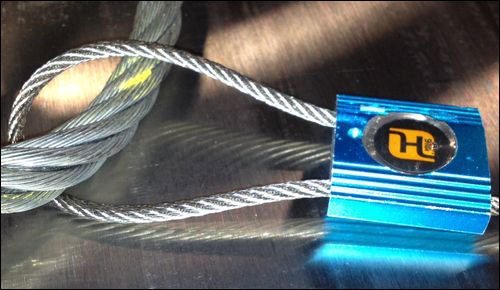West Coast Wire Rope (WCWR) is employing a new metal, ruggedized version of Holland 1916‘s DataCinch RFID tag to track maintenance records for the equipment that its customers in the logging, construction and marine industries purchase or lease. The firm’s rigging equipment is in use throughout Washington, Oregon, California and Alaska, in some very harsh environments. For the past five years, WCWR’s inspectors and maintenance staff have utilized handheld RFID readers to identify each item within the field, and to record the work performed. Recently, WCWR began using Holland 1916’s Metal DataCinch tags, which are even more durable, the company reports, and which can withstand physical impacts and water damage that could render a typical RFID tag inoperable.
The Metal DataCinch tag acts as a zip tie, with a metal cable that loops through or around an item, and is then cinched up, locking into place. The tag—a solid block of corrosion-resistant metal measuring approximately one inch in length and width and 0.37 inch in thickness—comes with either a high-frequency (HF) or ultrahigh-frequency (UHF) chip embedded in it, and is encoded with a unique ID number linked to information about the item to which it is attached.
WCWR sells overhead lifting products—such as slings, cable assemblies and railing systems—and then provides inspection services for those goods to its customers, either onsite or by means of a vertical pull-test machine located at its own facility in Oakland, Calif. Typically, information regarding inspections would be tracked manually, using paper and pen. West Coast Wire Rope, however, is utilizing Holland 1916’s RFID tags and N4 Systems‘ Field ID software to create and manage a digital record of when and how each item was inspected or maintained. This, the company explains, provides something that both customers and the Occupational Safety and Health Administration (OSHA) can access, by simply inputting a particular item’s serial number into WCWR’s Web-based system, or by reading its tag.
When a WCWR inspector is onsite, he or she can utilize a handheld RFID interrogator to capture the ID number of each tagged item scheduled for inspection. That ID is then forwarded via a Wi-Fi connection to a server hosted by N4 Systems. The inspector can proceed to perform any testing or maintenance necessary for that item, and then input that information for storage on N4 Systems’ cloud-based server.
Holland 1916 developed its latest durable tag, the Metal DataCinch, with the oil and gas industry in mind, according to Zack Barron, the company’s RFID sales specialist. He says there are not many environments more rugged for RFID tags than the oil and gas sector, in which tags on frac iron (pipes used in fracturing operations), pumps, slings and generators can experience a variety of abuses. Holland 1916 offered an earlier version of the DataCinch tag that could be affixed to equipment and then transmit an ID or other data when interrogated, but that model proved to be susceptible to damage at oil-field sites.
“We had customers who loved the technology but needed something that was more robust,” Barron states. The new one-way locking unit has a rating proof of 1,000 pounds, he says, noting that the company manufactures tags with abuse in mind. “When we make a new tag, the first thing they [customers] do is hit it with a sledgehammer.”
The metal cable tie loops around an object, Barron explains, and is intended to be virtually indestructible, while also being easy to install. “It doesn’t take epoxy, rivets or bolts,” he says, “and it’s the simplicity that people really like.” The tag can be attached in a matter of minutes, or even seconds, he adds, and thus can be retrofitted on potentially thousands of items at a work site in only a short span of time.
The Metal DataCinch tag is available in a UHF version (with an embedded Xerafy Pico-iN tag featuring 512 bits of user memory), compliant with the EPC Gen 2 standard, or as an HF 13.56 MHz version (built by one of Holland 1916’s partners and containing 256 bits of memory) that complies with the ISO 15693 standard.



